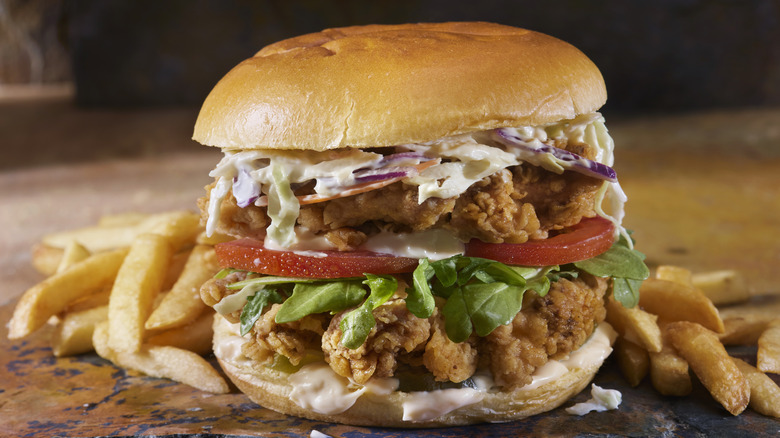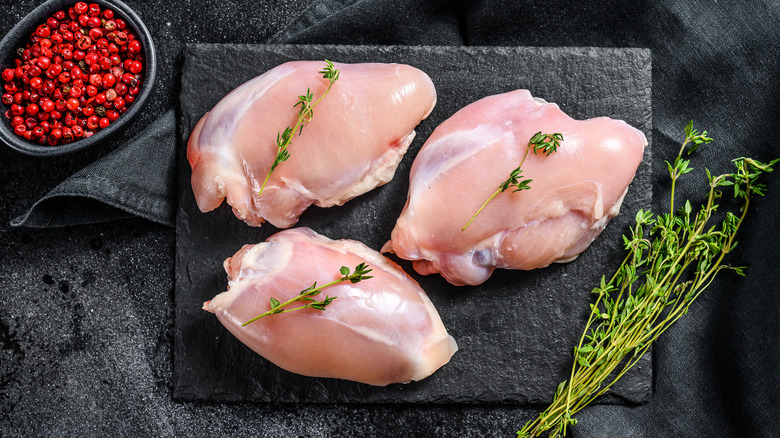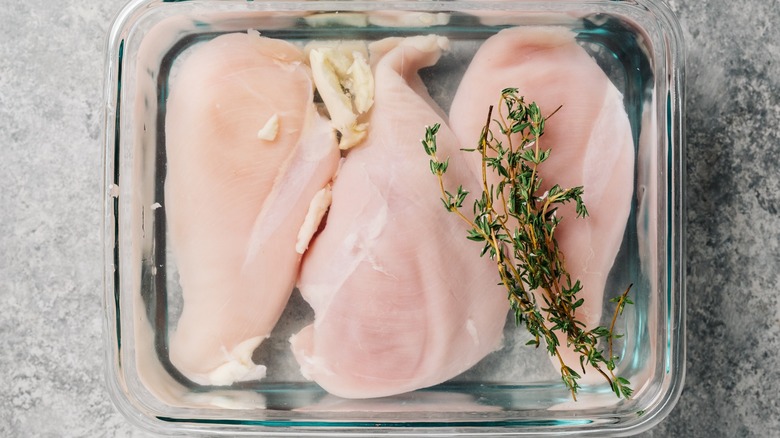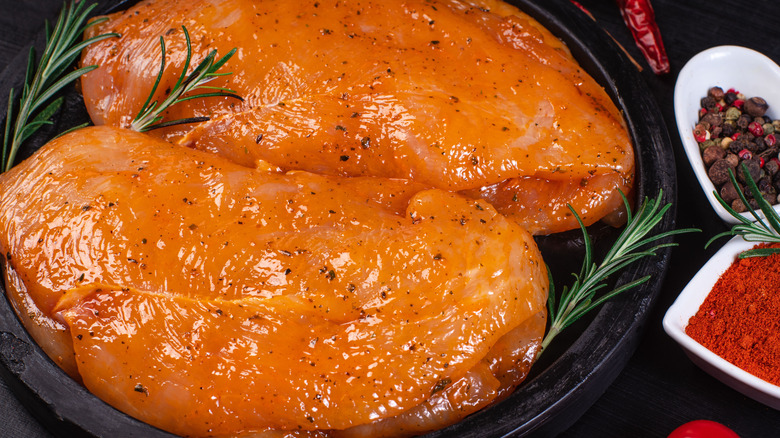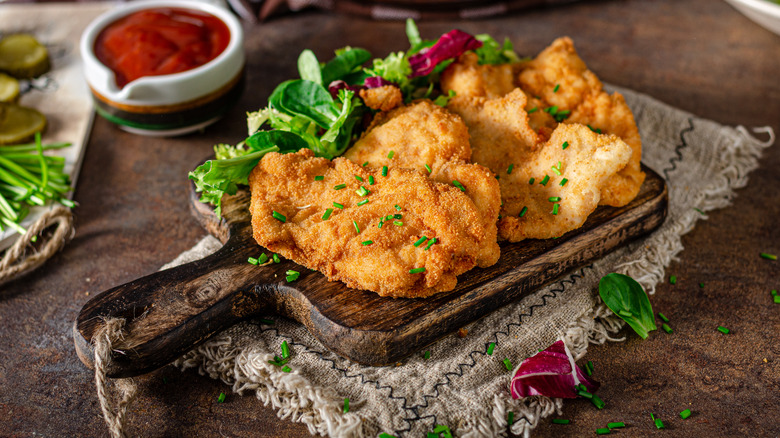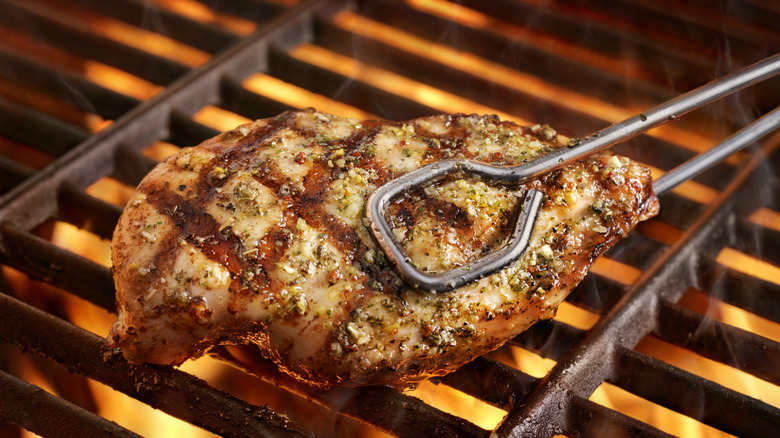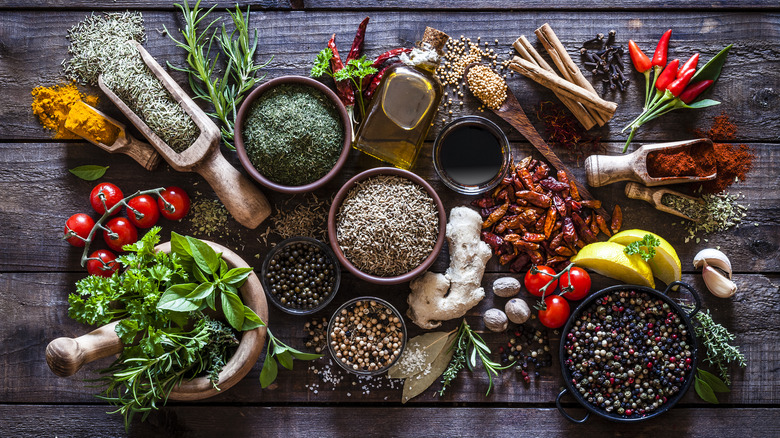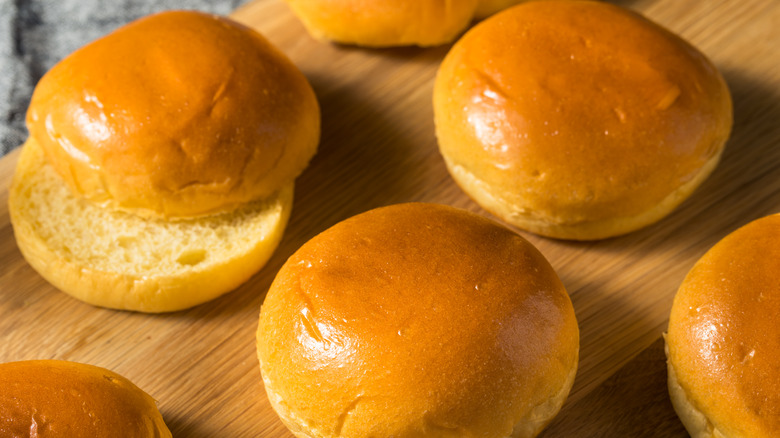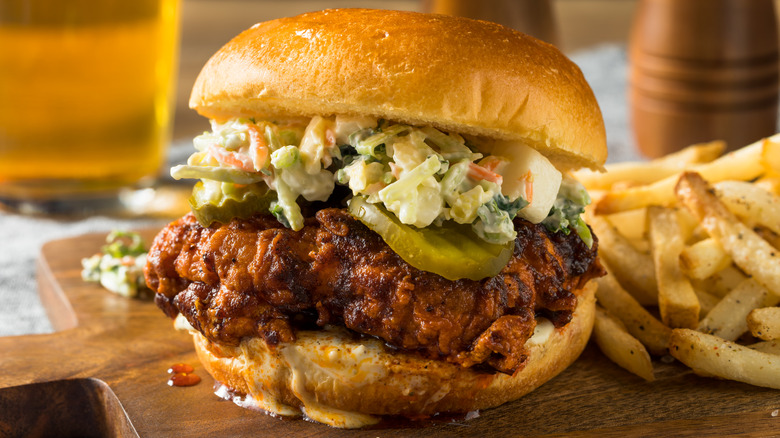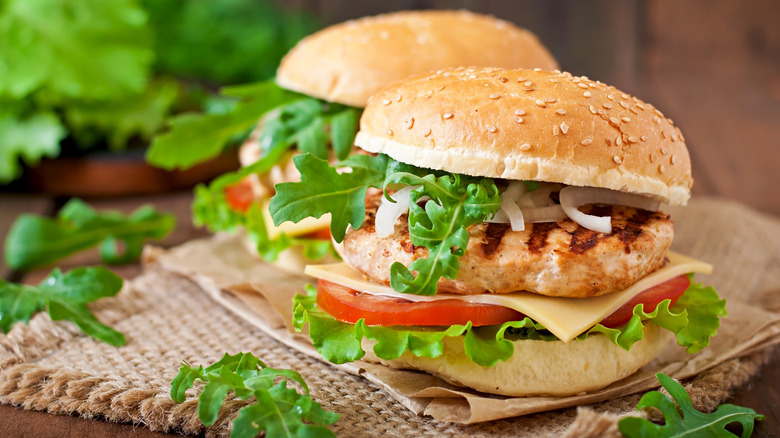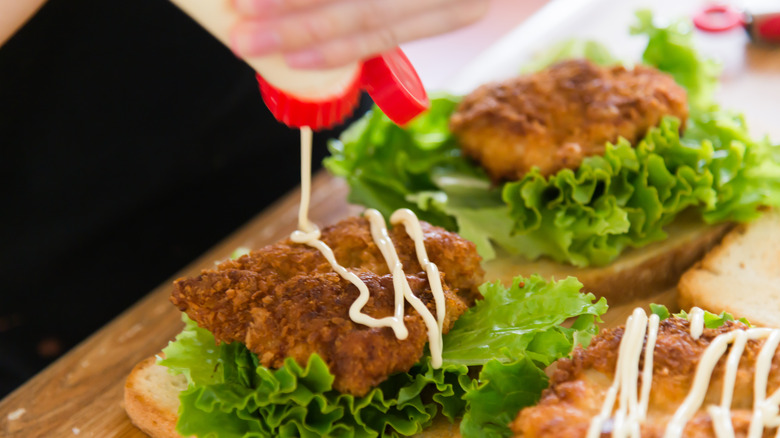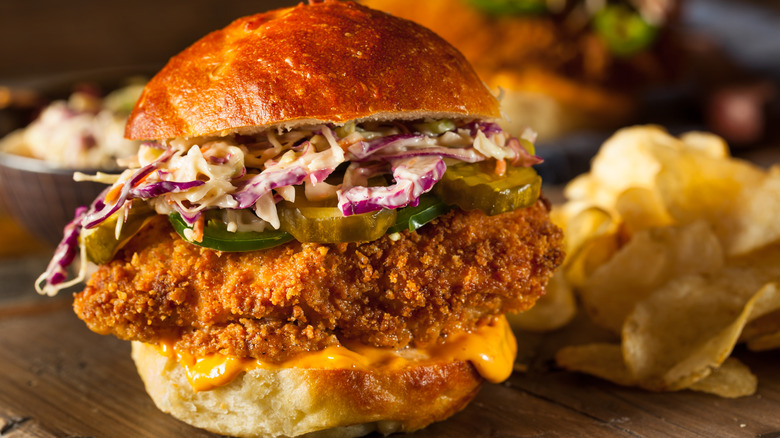11 Tips You Need To Make The Ultimate Chicken Sandwich
Move over beef, it's chicken's time to shine. It seems like every fast food chain has released its own version of a chicken sandwich over the past few years, and while some are certainly better than others, there are a few features that mark most stand-out sandwiches.
Filleted and fried or basted and barbecued, chicken is as versatile as any protein. Low in fat and mild in flavor, the bird is ripe for culinary experimentation in the form of cooking methods, marinades, sauces, and condiments — all key components of a worthwhile sammie. The art of crafting the perfect sandwich comes down to balancing a few main players: salt, fat, acid, and texture, all with a juicy cut of chicken in the center.
Versatility and affordability are two of the key reasons Americans consume so much poultry — over 100 pounds per person per year, according to the National Chicken Council. While there are endless ways to cook up a perfect chicken, sticking it on a sandwich might just be the most satisfying, if you know what you're doing. Below, some of the top tips for whipping up the ultimate chicken sandwich.
Pick your chicken
Of course, it's hard to make a great chicken sandwich without a quality cut of poultry. But how do you know which specimen is right for any given sandwich? When it comes to flavor, it's hard to beat a bone-in bit of bird. But taking a hearty bite out of a well-prepared sandwich and getting a mouthful of bone is a less-than-desirable scenario. For ease of preparation and perfect sandwich-shaped poultry, boneless, skinless specimens are the way to go.
Boneless, skinless chicken breasts may first come to mind when imaging the perfect protein. But the ultra-lean piece is too often dry as a bone (ironic, isn't it?) and ranks among the worst cuts of chicken when it comes to flavor. When shopping for a savory sandwich filling, reach instead for boneless, skinless thighs. A higher fat content all but guarantees a juicy final product and their smaller size makes them ideally portioned for a hearty sandwich.
Whether choosing to endorse the light or dark side of the chicken, the key to even cooking is to pound the poultry into thin, even cutlets. Sure, it may take a bit more time, but the tender and quick-cooking results speak for themselves.
Brine, baby, brine
No matter how someone plans to cook a chicken, a brine is the best way to ensure that the end result is a moist, flavorful bite. High in protein and low in fat, boneless, skinless cuts of chicken are prone to moisture loss, which can lead them to a dry, tasteless fate. Brining chicken is an essential step to reversing this effect and guaranteeing a delicious sandwich.
But what exactly is brining? Basically, it's the process of treating protein with salt to counteract moisture loss during cooking. A practice most often associated with Thanksgiving turkeys, brining should become a familiar step in preparing any type of lean protein, particularly poultry.
The best way to treat ultra-lean cuts like boneless, skinless breasts and thighs is with a wet brine. A basic recipe uses one cup of salt per gallon of water, brought to a boil, and allowed to cool completely before submerging the chicken. If feeling fancy, add aromatics to the salt water mixture, substitute broth, pickle juice, or beer for the liquid, or, if looking to fry, simply brine the chicken in buttermilk.
While it may be tempting to let the protein soak in an effort to create a more tender product, never brine the meat for too long or risk the mushy side effects. The golden rule is to brine just one hour per pound of protein.
Soak up some extra flavor
To bring extra flavor to the chicken sandwich party, consider soaking the protein in a mouthwatering marinade. The difference between a brine and marinade is that while a brine is absorbed deep into the meat to help it retain moisture, a marinade's primary purpose is to impart flavor. Both can help with tenderizing chicken.
The key components to a quality, well-seasoned marinade are fat, acid, and flavor — typically a combination of oil, citrus or vinegar, and aromatics — designed to supercharge dull proteins like chicken into show-stopping entrees. The three elements work in tandem to yield the best chicken: The fat helps prevent moisture loss, aromatics impart flavor, and the addition of acid aids in breaking down tough proteins, resulting in an extra-tender bird.
A marinade is a flavorful route for those short on time, since the chicken only needs about an hour or so to soak up some serious flavor, though it could certainly be marinated for longer. Just like with a brine, be sure not to leave the chicken resting for more than 24 hours in the flavorful mixture. The same chemical reaction that leaves protein tender and juicy can potentially render it mushy and unpleasant.
For the ultimate chicken sandwich, a combination of brine and marinade could be just the ticket. If going this route, be sure to leave the salt out of the marinade — the chicken has absorbed plenty from the brine.
Keep it crispy
There's something both soothing and satisfying about biting into a fried chicken sandwich. Juicy on the inside, crispy on the outside, it's a textural symphony that makes tastebuds sing. But that gorgeous, golden crust doesn't just happen on its own. There are a few secrets to making the best fried chicken sandwich.
The first tip for making a super crisp crust is to pick the right type of breading. Regular breadcrumbs work just fine, but for crunchy perfection, go panko. The Japanese-style breadcrumb is larger, crisper, and absorbs less oil than its Western counterpart, making panko the ideal choice for fried chicken.
Next, focus attention on the dredge. This three-step process (a coating of flour, a dip in egg, and a toss in panko) ensures an extra-crispy crust that actually adheres to the final product. For the crispiest chicken cutlets, add a bit of cornstarch to the flour. The starchy secret ingredient does double duty by helping wick excess moisture from the chicken, developing a super-crunchy crust when it hits hot oil — the dynamic duo of moist yet crisp perfection.
If looking to go above and beyond the crispy call of duty, try adding cornmeal or crushed cornflakes to that panko. The extra texture might just elevate the chicken sandwich from basic to brag-worthy.
To fry or not to fry
Not all cooking methods are created equal and not all chicken sandwiches need to be fried. The beauty of poultry is its versatility, including the dozens of different ways chicken can be cooked to achieve maximum flavor.
Grilling can infuse a bit of summertime deliciousness into protein any time of year. To achieve a signature smoky taste and crispy charred crust, be sure to keep the temperature of the grill in check. It can be tempting to crank the heat all the way up to hear that satisfying sizzle, but it risks burning the outside before the meat has a chance to cook. Preheat the grill to a toasty 425 to 450 degrees Fahrenheit before grilling the chicken for about 10 minutes, flipping only once halfway through to ensure even cooking.
Even if choosing to fry, there are options. Most restaurant-style sandwiches are deep fried, which can be a messy endeavor to replicate at home. Opt instead to pan-fry the chicken cutlets to achieve that crisp, golden crust with less of a mess, or try out a handy air-fryer for a slightly healthier alternative to traditional deep-fried goodness.
If opting to deep fry, don't despair — it just takes a little extra preparation to achieve a golden reward. Heat the oil in a hefty Dutch oven, using a thermometer to keep an eye on the temperature (keep it between 325 and 400 degrees Fahrenheit) while frying that chicken to crispy perfection.
Spice it up
Even the most perfectly cooked chicken cutlet can't be saved from a lack of seasoning. If the chicken is the headliner, the crust is the opening act — if the opener fails to hype up the crowd, then the whole show will leave a bad taste. Eliminate the risk of a bland chicken sandwich with a little savory insurance.
Between the brine and maybe a marinade, the chicken will have soaked up plenty of flavor. In order to ensure that the crust doesn't fall short of mouthwatering expectations, it's important to season the flour. A hearty sprinkle of salt and pepper will do the trick, but flour's uber-bland nature provides the perfect canvas for signature flavors to shine. Try spicing things up with a kick from Cajun-inspired seasonings, or opt for a savory symphony of dried herbs like thyme or oregano for a Mediterranean twist.
While seasoning the flour prior to cooking is one way to incorporate flavor into a sandwich, tossing freshly fried chicken in flavored butter can add an extra dose of goodness to the finished product. Nashville hot chicken is a prime example of this tasty technique: A mixture of melted butter, cayenne pepper, brown sugar, paprika, and other spices is brushed over crispy, golden chicken for a sweet heat that can't be beaten — especially when stuffed between two buns.
Sun's out, bun's out
Now that the chicken is on the road to perfection, it's time to turn attention to sandwich construction. A sturdy yet delicious foundation is needed to build the ultimate chicken sandwich, so it stands to reason that the best bun for burgers is likely to be a top contender for poultry as well.
When it comes to building a stacked sandwich, the bun should be firm enough to hold onto all of that hard-earned goodness, yet have enough give that the toppings don't slide out the sides. A soft, slightly sweet French brioche bun fits the bill with a lightly crisp exterior, fluffy interior, and mild-enough flavor that lets the flavor of the fillings shine.
Of course, bun selection is not a one-size-fits-all proposition. If brioche isn't conducive to the desired taste, try Italian ciabatta (which pairs well with salty toppings like bacon), a traditional sesame seed bun, or a Kaiser roll. Each of these options provides a stable yet flexible crust and a soft interior that's ideal for soaking up all those delightful chicken juices.
No matter which bun is selected, give it a light toasting. Heating up the packaged bread releases water that gets reabsorbed into the bun, rehydrating and returning it to a state of bakery freshness.
Add some acid
The best way to build a mouthwateringly memorable sandwich is to balance flavors. Whether it's been grilled to smoky perfection or fried golden brown, the chicken covers the salty and fatty bases with its savory goodness. What's needed next is a little brightness to cut through all that rich flavor. That's where acid comes in.
Possibly the most popular acidic sandwich topping, pickles are a classic fried chicken pairing for a reason. The tart, briny pop of a pickle slice matched with a crispy, salty cutlet is a pleasing sensation for tastebuds because as the acid enhances the salt, the fat tones it down, resulting in a perfectly balanced bite.
Not a fan of pickles? Not a problem. A classic coleslaw dressed with a lemon-zinged mayo or a light and fresh vegetable slaw (yes, coleslaw and slaw are two different dishes) with a citrusy vinaigrette should do the trick — just be sure to make it fresh to avoid bland flavors or soggy vegetables. Even delicious fermented condiments like kimchi can bring a brightness to any sandwich.
Time for texture
Don't overlook texture as a component of the ultimate chicken sandwich. Even the most flavorful sammie can fall victim to monotony if there's no textural contrast to be found. Avoid one of the most common cooking mistakes by carefully considering those chicken sandwich toppings.
One approach to adding texture (and an extra dose of vegetables) is to include fresh produce in a chicken sandwich construction plan. Of course, lettuce, tomato, and raw onion bring a classic crunch to any sandwich but using more flavorful greens like arugula or mustard greens, unique heirloom tomato varieties for eye-pleasing color, and sweet heat in the form of Vidalia onions instead of simple white or yellow specimens is a winning strategy. No matter how it is dressed up, the refreshing bite of fresh produce helps cut through the juicy richness of a well-cooked chicken cutlet.
For a twist on a chicken sammie, consider trying alternative sources of fibrous flavor such as thinly sliced cucumbers, bell peppers, jalapenos, or even pineapple. If looking to add some extra crunch to a tender grilled chicken sandwich, consider including some fun fillers like bacon or potato chips to balance out a sweeter marinade with a salty bite.
Feeling saucy
For one final flourish, top the sandwich with a smooth, creamy sauce. Store bought sauces can be a cook's secret weapon, but the homemade variety will earn extra credit in the kitchen. Since many sandwich-favorite sauces are simply flavored mayonnaise, they can be easily whipped up at home.
When it comes to adding that last boost of flavor, let the ingredients be a guide. If going for hot and spicy tempered by a cool, tangy coleslaw, add a dose of buffalo sauce. Looking for a hit of sweet and savory goodness? Add a dollop of honey mustard.
While the classics are all well and good, try mixing things up with a non-traditional spin on a family favorite, like tangy Alabama white barbecue sauce, or with a hibachi staple like mouthwatering yum yum sauce. Those who prefer to skip the mayo can spice up their sandwich by adding a smoky condiment with international flair. Romesco sauce may not be in everyone's culinary repertoire, but it should be. The smoky blend of roasted red peppers and tomatoes, paprika, sherry vinegar, and almonds elevates any chicken dish (especially a grilled chicken sammie) to dinner party status.
Stack it up
Once all the flavorful components are ready, it's time to start construction. Believe it or not, there is a science to making a restaurant-quality chicken sandwich at home. The construction of a chicken sandwich makes a huge difference not just in how it looks, but how the final product tastes.
First, toast the buns — that bottom layer of toasty goodness needs a little extra support to hold up all of those beautiful fillings. Next, add the chicken. As tempting as it is to start with a layer of sauce, the most substantial fillings need to be added first to keep the structural integrity of the sandwich intact.
After the chicken, add acid and textural toppings before slathering a generous dose of sauce on the top bun and stacking it on top. As the moisture from the sauce, vegetables, and other toppings drips downwards, the chicken will stop (or at least slow) it from penetrating the bottom bun. Eat first with the eyes (and phone), then dig into the ultimate chicken sandwich.
